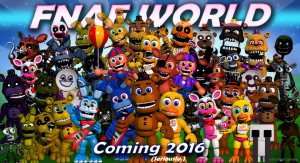By Zachary Landau | The Duquesne Duke

“FNaF: World” is a spin off from the popular horror franchise “Five Nights at Freddy’s.” While featuring the same characters, it switches out the point-and-click gameplay for a turn-based RPG one
It came as no surprise to anyone familiar with the infamous “Five Nights at Freddy’s” franchise that its latest entry, “FNAF World,” was released early. Originally slated for a Feb. 19 release, the RPG-spinoff was put on Steam for purchase last Thursday to very little pomp and circumstance.
What did surprise the fan base, however, was the state the game was in. Its creator, Scott Cawthon, openly admitted that certain features, such as seeing character’s stats and move effects, were excluded and would be added later. He even pulled the game last Monday from online distributors and offered full refunds. After playing the game, however, it is apparent that no update in the world would solve its real problems of being an incomprehensible optical nightmare that is not worth the time.
The plot is, for the most part, obtuse. Apparently there is something wrong with the game world, with different parts of the environment glitching, and it is up to the player to dig deeper and figure out why. Story progression is thin on the ground, with the objective for most of the game being to find the path to the next text dump. The goal is made obvious at the forefront, and nothing in-game elaborates on the world or the story. There are tons of hidden details that explain the wider “FNAF” story arch, but if players are not already heavily invested in the games’ lore, then there is nothing here to entice them.
Similarly, the game’s progression is stagnant throughout its 4-hour run. The gameplay is split between exploring the overworld and random, turn-based battles. The combat proves to be the most abhorrent and broken part of the game. It runs on an active-time system, meaning attacks are regulated to a timer and can be extremely fast-paced. Battles rarely run for longer than a minute or two, which is a double-edged sword. It makes the random encounters more bearable and grinding for money is less of a chore, but it leaves no time to understand what is going on, forcing players to hopelessly fumble with the game’s mechanics while robotic mice beat them mercilessly.
Once one does figure out how the combat works, however, the game becomes a push-over. Within 40 minutes of playing, certain combinations of characters and moves start steam-rolling opponents in seconds. The combat is made even more effortless when bytes and chips (“World’s” versions of buffs and assists) are equipped, leading to many instances when the battle would end before an attack was even chosen.
There is certainly more to critique about the combat, but, needless to say, it truly dragged down the experience. The exploration fared much better, and the game would have been improved if it relied on it entirely. Throughout the over-world are entrances to a sub-world that allows the player to cross underneath barriers in the “real” world and reappear in previously inaccessible areas. It can be fun deciding where to reemerge and exploring deeper into the sub-world (which has two sub-worlds beneath it as well), but that fun is relatively short-lived as most of the routes in the sub-worlds are simply linear paths.
It is a shame that the game did not focus more on these sub-worlds because they were not only the best part to play but were visually engaging as well. Each level that you dive into becomes increasingly simple and distorted, with the third and final level being primarily composed of white squares on a black background. There is also an interesting fish-eye effect overlaying these sections, which helps promote the feeling that the game’s reality is being distorted as you delve deeper into these worlds. However, this fish-eye is also present in the over world, and even though it is much less severe, it is still heavily disorienting when imposed on the Atari-2600-style graphics.
Indeed, the visuals in “FNAF World” are truly abhorrent, particularly in combat. For whatever reason, combat switches the characters to 3D models that have about five frames of animation and places them on a compressed background image. The effect is nauseating (and I mean that literally; I felt sick during one particular battle) and is not helped by the constant twitching of the characters and the numerous flashes occurring during attacks. There is an epilepsy warning upon booting up the game, and it was immediately apparent as to why: The game an assailing wreck that constantly flashes different lights and has characters wildly shake back-and-forth at the player. After playing for so long, I just wanted the game to end because of how sick it was making me feel.
“FNAF World” is a visual mess that is poorly paced and could make you lose your lunch after playing for too long. Even though it is technically not finished, its problems are so deep-rooted that simple content patches will do nothing to fix this horribly broken assault to the senses. Avoid.

